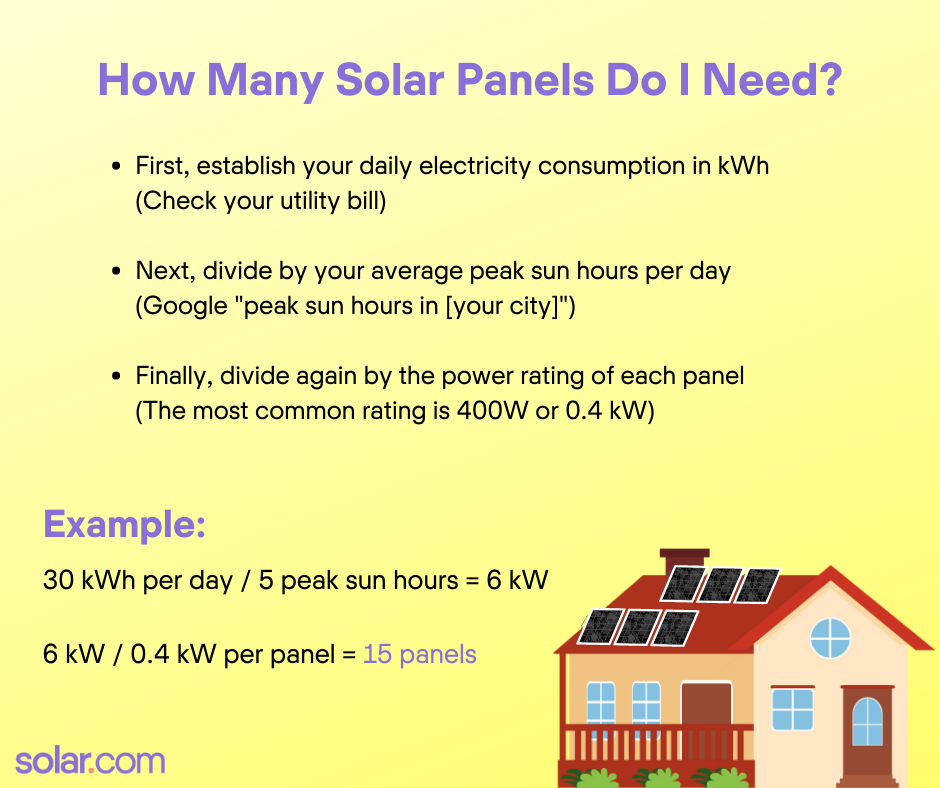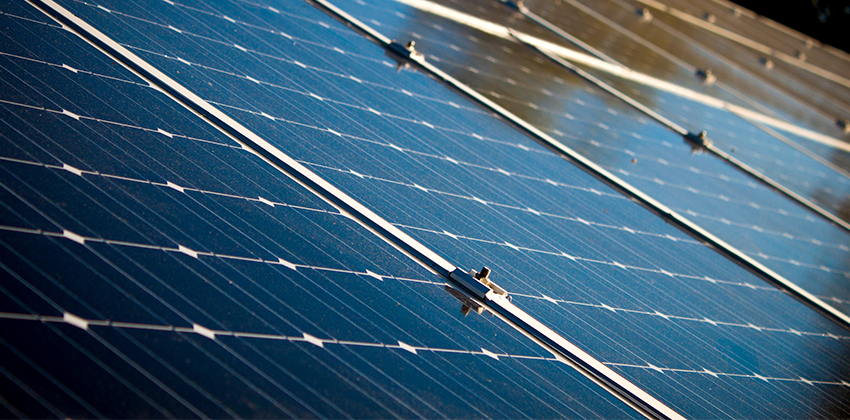
One of the first questions homeowners ask when going solar is “How many solar panels do I need to power my home?”
The goal for any solar project should be 100% electricity offset and maximum savings — not necessarily to cram as many panels on a roof as possible. So, the number of panels you need to power a house varies based on three main factors:
- How much electricity you use
- How much sun your roof gets
- Solar panel power rating
In this article, we’ll show you how to manually calculate how many panels you’ll need to power your home. Once you know how many solar panels you need, you’re one step closer to finding out how much solar costs for your home, and how much you can save on electricity bills.
Pssst: The “One Big Beautiful Bill” signed into law on July 4 terminates the 30% tax credit for residential solar at the end of 2025. Homeowners need to have their solar systems installed by December 31, 2025 to claim this credit before it is gone. Start your project today to lock in a 2025 installation and your home’s full savings potential!
How many solar panels do you need to power a house?
While it varies from home to home, US households typically need between 10 and 20 solar panels to fully offset how much electricity they use throughout the year.
The goal of most solar projects is to offset your electric bill 100%, so your solar system is sized to fit your average electricity use. Here’s a basic equation you can use to get an estimate of how many solar panels you need to power your home:
Solar panel wattage x peak sun hours x number of panels = daily electricity use
Obviously, electricity use, peak sun hours, and panel wattage will be different for everyone. And since you didn’t come here to do algebra, we’ll go through how to figure out each variable and run through an example scenario based on national averages.
Related reading: How Do You Calculate the Number of Panels on a 16 kW Solar System?
First, find how many kilowatt-hours you use to run your house
According to the latest data from the US Energy Information Administration (EIA), the average US household uses 10,791 kilowatt-hours (kWh) of electricity per year. That’s equal to:
- 899 kWh per month
- 30 kWh per day
It’s important to note electricity usage varies quite a bit from state to state. For example, the average daily usage was ~18 kWh in Hawaii and 40 kWh in Louisiana, which is quite a spread. But we’ll use the national average 30 kWh per day as the figure for our example.
The easiest way to find your daily electricity usage is to dig up some recent utility bills. Your bill should show your usage for 30 days (or whatever your payment period is) and you can use this to get a sense of your daily electricity consumption. Just take the total usage during the period, and divide it by the number of days. Electricity usage varies from month to month, so the more bills you can average together, the more accurate your calculation will be.
Once you have your daily electricity usage, the next step is to figure out how many peak sun hours your system will get per day!
Next, determine how many peak sun hours your location gets
A big factor in determining how many solar panels you need to power your home is the amount of sunlight you get, known as peak sun hours.
A peak sun hour is when the intensity of sunlight (known as solar irradiance) averages 1,000 watts per square meter or 1 kW/m2.
In the US, the average peak sun hours range from over 5.75 hours per day in the Southwest to less than 4 hours per day in the northernmost parts of the country.

Use the map above to estimate your average peak sun hours, or use this peak sun hours calculator to get a more precise figure for your location. Here are some tips for using the peak sun hours calculator:
- The average roof pitch is between 14 and 27 degrees
- Use the compass on your phone to determine the Azimuth Angle of the roof face you’d put solar panels on (closest to 180 degrees is best)
Based on the map, about half of the US gets less than 4.5 peak sun hours and half gets more, so we’ll use 4.5 peak sun hours as the figure for our example.
Related reading: How Much Is a Solar System for a 2,500 Square Foot House?
Finally, pick a solar panel power rating
The final variable is how much electricity each solar panel can produce per peak sun hour. This is called power rating and it’s measured in Watts. Solar panel power ratings range from 250W to 450W. Based on solar.com sales data, 400W is the most popular power rating and provides a great balance of output and Price Per Watt (PPW).
If you have limited roof space, you may consider a higher power rating to use fewer panels. If you want to spend less per panel, you may consider a lower wattage. Everybody has different goals, and you should feel free to choose the panels that best suit your needs.
For the purposes of our example scenario, we’ll use 400W panels.
Related reading: How to Choose Solar Panels for Your Home
Calculate how many solar panels it takes to power a house
Now that we have our three variables, we can calculate how many solar panels it takes to power a house.
- Daily electricity usage: 30 kWh (30,000 Watt-hours)
- Average peak sun hours: 4.5 hours per day
- Average panel wattage: 400W
To solve for the number of solar panels, we can rewrite the equation above like this:
Daily electricity usage / peak sun hours / panel wattage = number of solar panels
Now let’s plug in our example figures:
30,000 Watt-hours / 4.5 peak sun hours / 400W = 16.66 panels
If we round up, it takes 17 solar panels to power the average American household and meet the goal of 100% electricity offset. And since we’re talking about national averages, the average price of utility electricity in 2024 is nearly 18 cents per kilowatt-hour. Meanwhile, the cost of electricity from a rooftop solar system breaks down to around 8 cents per kilowatt-hour.
I’ll let you do the math there.

The easy way to find out how many solar panels you need
Now that we’ve gone through the manual calculations of finding out how many solar panels you need to power a house, we’ll show you the easy way.
Modern home solar projects are planned using satellite technology, and you can start planning your own project using our solar calculator. Simply punch in your address and set your average energy bill to calculate how big your solar system needs to be and how much you can save by switching to solar.
Under the average energy bill slider, the calculator will give you an estimated system size in kW. You can use this number to figure out how many panels you would need.
First, convert kW into Watts by multiplying by 1,000. So 5.2 kW would be 5,200 W.
Next divide the total system size in Watts by the power rating of the panels you’d prefer. If we use 400W, that would mean you need 13 solar panels.
System size (5,200 Watts) / Panel power rating (400 Watts) = 13 panels
Of course, the easiest way to know how many solar panels you need is to team up with an Energy Advisor to design a custom system.
Frequently asked questions
How many solar panels does it take to run a house?
The average US home needs between 13-19 solar panels to fully offset how much electricity it uses throughout the year. This number varies based on your electricity usage, sun exposure, and the power rating of the solar panels. Use the equation below to get an estimate of how many solar panels you need to power a house.
Daily electricity consumption / peak sun hours / panel wattage = number of solar panels
Can I run my house on solar only?
Absolutely. By pairing solar panels with battery storage, it is very possible to run a house on solar power alone. And in many areas, it’s cheaper than paying for electricity through a local utility.
Without battery storage, you can use a combination of solar and grid electricity to run your house. In this case, you can reduce the cost of buying grid electricity by selling your excess solar power back to your utility through a “net metering” or “net billing” program.
Is 10 kW enough to run a house?
Yes, in many cases a 10 kW solar system is more than enough to power a house. The average US household uses around 30 kWh of electricity per day, which can be offset by a 5 to 8.5 kW solar system (depending on sun exposure).





